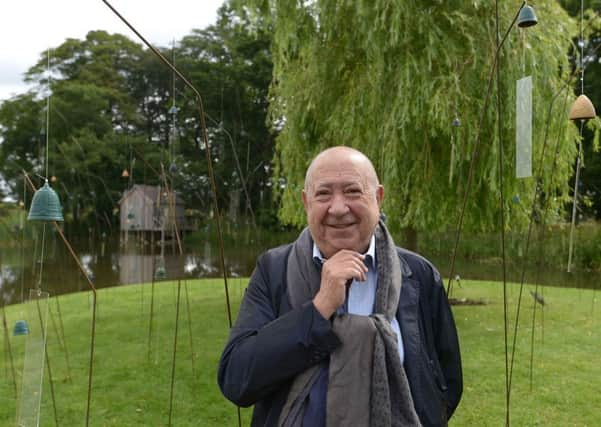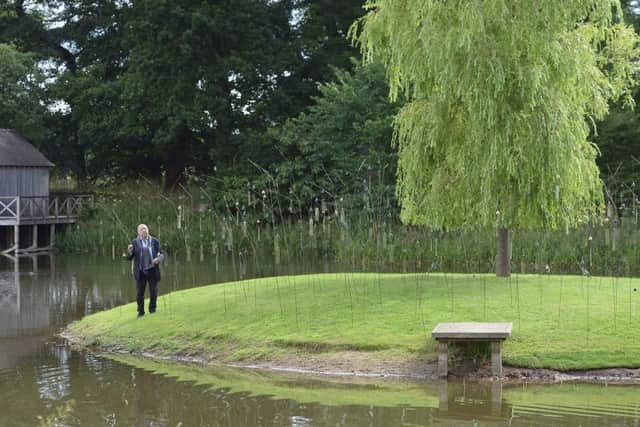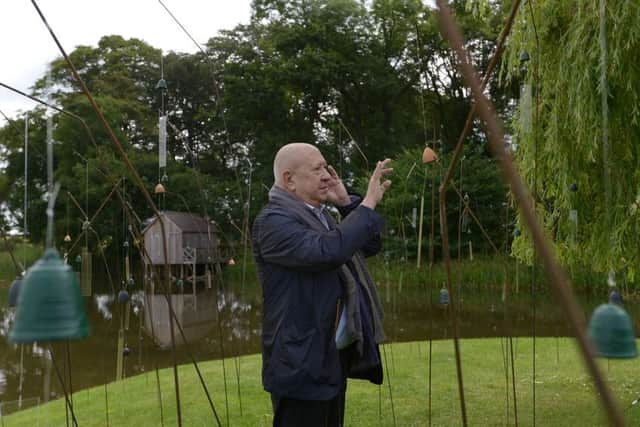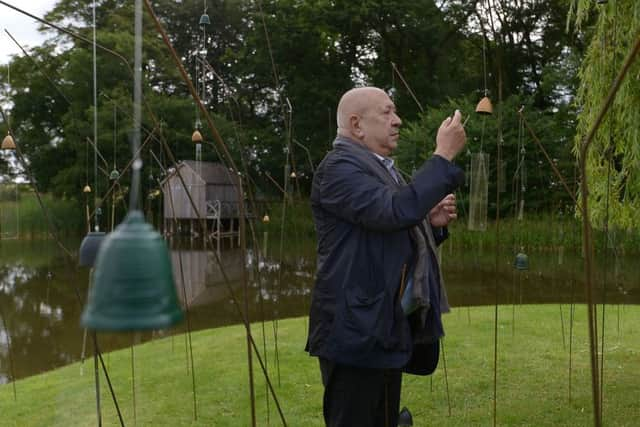SPIRITS IN'¨THE SKY


‘Cold country,” mutters Christian Boltanski, trying to draw his scarf more tightly round his neck.
The veteran French artist has exchanged the balmy temperatures of summer in Paris for the chill winds of West Lothian to supervise the installation of Animitas, a new permanent work for Jupiter Artland.
Advertisement
Hide AdAdvertisement
Hide AdOn an island in the duck pond, fine reed-like wires, each with a little Japanese bell attached, are bending and tinkling heartily to the gusts coming off the Pentlands. Laid out as a map of the stars on the night Boltanski was born, the work is intended as a place of meditation. “I believe there are a lot of small spirits around us and they are like the spirits of people,” he says “We can’t see the wind but the wind is very present, the wind touches us like people can touch us.”


A larger version was created two years ago in Chile’s Atacama desert (a webcam beamed the work to a gallery in Santiago). “This piece is now destroyed, I think. I didn’t want to preserve it because I think it’s awful to destroy the desert, the desert is so beautiul. There might be two little bells somewhere, I don’t know. This is the same and not the same piece because it’s working with a different kind of landscape. For me, it’s a very traditional romantic English garden with the little lake.”
Boltanski, 71, is a distinctive and hugely respected artist, and a permanent commission for Jupiter Artland is another feather in the cap of this already important collection. Two further works are on display here for the summer as part of Edinburgh Art Festival: an early piece, Hombres, from 1984, inspired by shadow puppetry and the Mexican Day of the Dead, and a machine for recording the heartbeats of visitors. These will then be added to an archive of more than 90,000 heartbearts housed in a museum on the Japanese island of Teshima.
The major preoccupations of Boltanski’s work are mortality, memory, what we leave behind. “The big difference between a fashion designer and an artist is that an artist must have only one idea, all his life,” he says, with self-deprecating good humour. “You find different ways to look at that idea.”
With his shaved head, he looks a little like a Buddhist monk, and has something of that same spirit about him, an ability to hold heavy things lightly.


Although he has no religious belief, he sees the role of the artist as being similar to that of shaman, philosopher, priest. “I think they are people who try to understand. We can’t understand why we must suffer, why we must die and so on. Everybody is looking for a key, to try to understand. To be human is to look for the key. The big difference is that religious people believe that they have an answer. I don’t have an answer. I’m afraid of the people who believe their own answers.”
Art, he says, comes out of trauma. “I think in the beginning of the life of an artist is always a trauma, and all our life we try to speak about this trauma.” For him, it was growing up with the legacy of the Second World War and the Holocaust (he was born in 1944, while his Jewish father, a doctor, was being hidden from the Nazis by his mother’s family). “When I was very, very young, two or three years old, many friends of my parents would come who were survivors of the Shoah. They spoke and spoke and spoke, and I’m sure for a very young boy it was very terrible. I think a large part of my life and my art can be explained with this idea.”
Advertisement
Hide AdAdvertisement
Hide AdHe was, he says, “a very strange little boy” who stopped going to school at 14, but was drawn to art. After his older brother admired a drawing he made, he made hundred of paintings, “bad paintings, but hundreds of paintings”. “If I had not had nice parents, I might have ended up in hospital, I could have ended up an outsider artist. Art saved me. Making art is like a long psycho-analysis.”
While he rarely references the Holocaust directly, it is present in much of his work. He has made installations using found photographs from the Jewish school in Vienna in 1931, and major works in the Grand Palais in Paris and the Armoury in New York using tons of discarded clothing. The materials he is drawn to are ordinary ephemeral things: family photographs, biscuit tins. He once filled a gallery in London with 3,000 telephone directories, which visitors could consult to find lost friends or relatives.


The archive of heartbeats works this way: each heartbeat is as unique as a fingerprint, a record of a life. “You can go there and say: ‘I want to hear the heartbeat of Mrs Smith’, and they will find it for you. Now, because I began this work some years ago, there are some people who have died. But if you hear the heartbeat of somebody who is dead, you are now going to feel their absence not their presence, it’s like looking at an old photograph.”
He sees potential, he says, for a work using social media, the lingering Facebook profiles of those who have died. “All computers are big archives and Facebook is a big archive. It is so strange because Facebook seems to be something very happy, but in fact it’s full of dead persons. I try for a long time to make a piece about Facebook,” he says, sadly. “But it’s difficult to find the dead.
“The idea of progress in art is the most stupid thing you can imagine. Art is not better now than it was 100 years ago. Art is always the same thing, it’s looking for God, sex, why we are here, the beauty of the natural. The only difference is that I use the language of my time.”
For an artist who has made work about mortality since his twenties, what does it mean to age? He answers with disarming honesty: “For a long time, the dying was for the others, and now the death is for me. When you are younger, the fact of dying is that it is others who die. Sometime, you know that you are going to die soon, it’s another way to look at the same problem.”


But he approaches the prospect with sanguine good-humour. “I’m much more quiet now, much more happy than I was.” He even has a bet with art collector (and keen gambler) David Walsh about how long he will live. Walsh made a deal with him to “buy” his life, filming his Paris studio 24/7 and beaming the footage live to his art museum in Tasmania. “He is going to have thousands of hours of my life, and at the same time he is going to have nothing because he won’t have my mind,” Boltanski smiles. “He wanted to buy my memory, in fact, and it’s true, he bought my memory: he knows who was in my studio four years ago, and I can’t remember!
Advertisement
Hide AdAdvertisement
Hide Ad“He pays me every month, and if I died now, he’d make a good bargain. If I die in two years, he’s going to lose money. He says he has never lost in his life and that I’m going to die soon.” He shrugs. You might win, I say. A smile, a twinkle in those deep-set eyes. “It’s possible.”
l Christian Boltanski: Sombras, Les Archives du Coeur and Animitas, Jupiter Artland, until 25 September